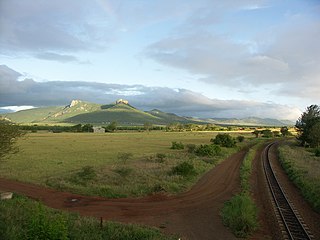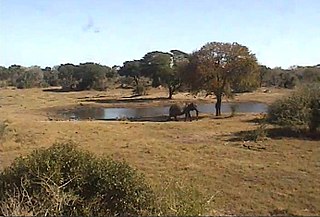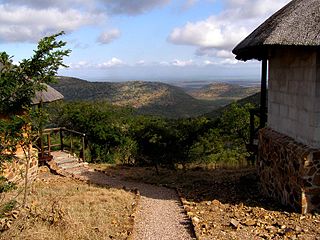The protected areas of South Africa include national parks and marine protected areas managed by the national government, public nature reserves managed by provincial and local governments, and private nature reserves managed by private landowners. Most protected areas are intended for the conservation of flora and fauna. National parks are maintained by South African National Parks (SANParks). A number of national parks have been incorporated in transfrontier conservation areas.

The Lebombo Mountains, also called Lubombo Mountains, are an 800 km-long (500 mi), narrow range of mountains in Southern Africa. They stretch from Hluhluwe in KwaZulu-Natal in the south to Punda Maria in the Limpopo Province in South Africa in the north. Parts of the mountain range are also found in Mozambique and Eswatini.
Protected areas in Mozambique are known as conservation areas, and are currently grouped into national parks, national reserves, forest reserves, wildlife utilisation areas (coutadas), community wildlife utilisation areas and private game farms. There are also a number of areas that have been declared as protected areas under a variety of different legislation, which for reasons of simplicity are here grouped together as "other protected areas." Under the Conservation Law of 2014, the protected areas will need to be reclassified into a much more flexible series of new categories which are closer to the international system used by the IUCN. International initiatives such as transfrontier parks are grouped at the end of the page.

Tembe Elephant Park is a 30 012 ha game reserve in Maputaland, KwaZulu-Natal, South Africa. It is adjacent to Ndumo Game Reserve.
Mlilwane Wildlife Sanctuary is Eswatini's oldest protected area, owned and managed by a non-profit trust.

Malolotja National Park covers 18,000 hectares of mountain wilderness on Eswatini's northwestern border with South Africa. The park includes Ngwenya Mountain, Eswatini's second highest mountain, and Malolotja Falls which drop 89 metres (292 ft), the highest in Eswatini. Habitats include short grassland to thick riverine scrub, bushveld and Afromontane forest.

Songimvelo Game Reserve is a provincial park managed by the Mpumalanga Parks Board in Mpumalanga, South Africa. Singimvelo is a plural word that means, we are conserving nature in the siSwati language.
The Songimvelo-Malolotja Transfrontier Censervation Area is a peace park located on the South Africa - Eswatini border between Barberton and Pigg's Peak (Eswatini) and covers an area of approximately 700 square kilometres (270 sq mi), with potential extensions of another 500 square kilometres (190 sq mi).
Usuthu-Tembe-Futi Transfrontier Conservation Area is a group of protected areas in southern Africa, straddling parts of South Africa, Mozambique and Eswatini, including the following:
Ponta do Ouro-Kosi Bay Transfrontier Conservation Area is an extension to the north of the iSimangaliso Wetland Park, in a similar area on the Mozambique side of the border, and including a few other parks in the process. They include:
Lubombo Conservancy-Goba Transfrontier Conservation Area, is a joint project between Mozambique and Swaziland, based on the Peace Park agreements. The park will include the following Area:
Maputo Special Reserve,, is a nature reserve in Mozambique. The reserve is located on Maputo Bay, approximately 100 kilometers southeast of the city of Maputo, Mozambique. The Reserve is 77,400 hectares in extent and was originally proclaimed in 1932. The reserve will eventually form part of the Lubombo Transfrontier Conservation Area, which includes national parks from South Africa, Mozambique and Swaziland. At the moment it forms part of the Usuthu-Tembe-Futi Transfrontier Conservation Area.
Futi Corridor, Situated in Mozambique, it is a corridor of land along the Futi River to the South African border. The corridor will effectively restore an historical migration and movement route of a valuable elephant population between Maputo Special Reserve and the Tembe Elephant Park in South Africa. The Futi Corridor covers 68.800 Ha. The Futi River is the northern extension of the drainage line known as the Mosi Swamp, which rises near Manaba about 55 km south of the border. The Futi River does not reach the sea, but ends in swamp grasslands in the north of the Maputo Reserve.
Mbuluzi Game Reserve is a privately owned reserve in Eswatini, within the Lubombo Conservancy. There are 3 lodges privately situated on the Mlawula River, and a campsite, situated above some rapids in the Mbuluzi River.

The protected areas of Namibia include its national parks and reserves. With the 2010 declaration of Dorob National Park, Namibia became the first and only country to have its entire coastline protected through a national parks network. Protected areas are subdivided into game reserves and/or nature reserves, such as special protected area, wilderness areas, natural areas, and development areas. There are also recreation reserves. Facilities in the national parks are operated by Namibia Wildlife Resorts. Over 19% of Namibia is protected, an area of some 130,000 square kilometres. However, the Ministry of Environment & Tourism auctions limited hunting rights within its protected areas. The Namibia Nature Foundation, an NGO, was established in 1987 to raise and administer funds for the conservation of wildlife and protected area management. Communal Wildlife Conservancies in Namibia help promote sustainable natural resource management by giving local communities rights to wildlife management and tourism.
Mbuluzi River is one of the main rivers of Eswatini.There are two sources of the river, one in the Highveld north of Mbabane forming the Black Mbuluzi and one in the Middleveld near Manzini forming the White Mbuluzi or imbuluzane. The river flows through the northeast of Eswatini especially through Hlane Royal National Park and Shewula Nature Reserve. The main dam fed by the river in Swaziland is the Mnjoli dam which is located not far from the sugar plantations of Mhlume. In Mozambique it becomes Umbeluzi feeding water to the Pequenos Libombos dam and ends at the Maputo Bay.










